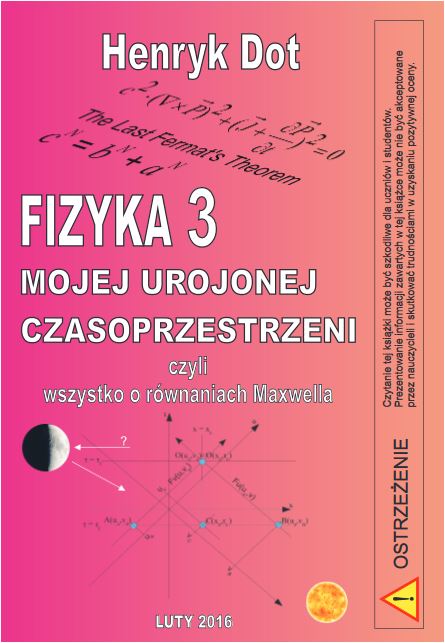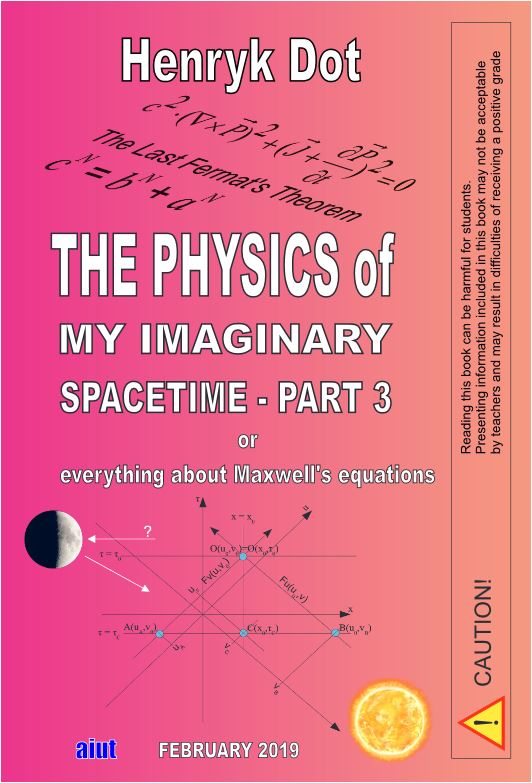|
I.2. Interesting historical facts regarding
Maxwell’s equations
Thanks to modern technology, we have now immediate access
to newest information such as copies of existing as well as newer
versions of historical documents. Use of key words in Internet search engines
easily allows to verify if newer sources of currently used information are available.
Thus, source references in this book should be treated as current
information at the time when the book has been published.
It is a good idea then to check if newer sources are available.
Detailed biographies of people who played significant roles in a progress
of science provide information no less important for education
than the knowledge about the subject itself.
The lack of biographical information in educational programs results in
acquiring superficial knowledge such as that Mr. Volta is this gentleman
who gave his name to voltage unit and Mr. Ampere’s name is used for a unit of
current flow.
It is good indeed that new measuring units were named after names of
contributing people, otherwise they will be forgotten.
However, not everybody was lucky like Mr. Volta or Mr. Ampere
whose units are still commonly used.
For instance, gilbert(Gb) which is a unit of magnetomotive force
has gone “out of use”, so people will not inquire anymore about
William Gilbert whose name was used for the unit.
However, his contribution to a progress of science was much greater
than many others whose names are still popular in discussions and publications.
Google and other search engines will show many references to Maxwell’s equations
and it becomes difficult to select real valuable ones.
Almost every author who writes about electricity feels a need to include
some history of electricity in an introduction,
information usually limited to names, dates and general data.
From our perspective it is interesting if scientific research preceding
creation of Maxwell’s equations is essentially related to these equations,
not judging whether Maxwell used such research.
The use of the word “essential” emphasizes new approaches to known
already physical phenomena rather than someone else was already
investigating these subjects.
Factual and comprehensive information about most of scientists who are
mentioned in this book can be found (as recommended already
in my previous book) on Internet – website at
University of St. Andrews in Scotland - referred by well
recognized scientists: John J. O’Connor and Edmund F. Robertson which is available
here.
The history of Maxwell’s equations should begin with already mentioned
William Gilbert (1544-1603). The link to information about him is
here.
Gilbert was the first who stated that compass indications are not caused by
some abstract objects such as stars or islands but are affected by
proximity of magnet, and this magnet is our planet Earth.
He introduced the term of electric forces between electric charges
similar to magnetic forces between magnets.
He also constructed the device to measure electric charge
called “versorium” which was the first electroscope – device
to measure electricity. Therefore, he opened a way to further studies on electricity.
Gilbert was born one year after Copernicus’(1473-1543) death
and he was heliocentric believer which, at the time had not given him many supporters.
For readers who like antique books, my recommendation of Gilbert work (
archiv)
as well as early approach to history of electricity (
bodleian).
We had to wait for further progress in electricity research…
Just after 50 years after Gilberts’ death, Otto van Guericke
constructed electrostatic machine so experiments with electrostatic charges
became easier.
Guericke was born one year before Gilbert’s death, but next person who really
contributed to knowledge about electricity was not born until 12 years after
Gilbert’s death and he was Charles François de Cisternay du Fay (1698–1739).
Fay recognized two types of static electrical charges, which today we name as
positive and negative charge. Gilbert, at his times already suggested that
this negative is due to the effect “missing” positive,
which is close to our today’s knowledge about electrons.
Of course, Gilbert did not use the terms ‘positive” or “negative”.
Only after the death of du Fay, around 1746 the Leyden jar was invented
which allowed to store electric charge, thus allowing for further
experimentation with electricity. Few names are related to invention of Leyden jar:
Daniel Gralath, Pieter van Musschenbroeck, Ewald Juergen Georg von Kleist.
More information
on WEB.
Quite interesting is associated Polish involvement – see
Polish Web site.
Leyden jar and electrostatic machine allowed for conducting numerous experiments,
but have not really expanded a knowledge about electricity.
Charles Augustin de Coulomb (1736–1806), in 1784 formulated his Coulomb law,
which is not visible in Maxwell’s equations, but it can be seen in their solutions.
Quick progress in electricity knowledge can be related to
Alessandro Volta (1745-1827), who was born after Leyden jar was already invented.
Over 50 years passed when around 1800 so called “Voltaic pile” was invented.
This provided constant source of voltage, thus constant source of electric current.
This accelerated the subsequent inventions in electrical field.
First, Hans Christian Oersted (1777–1851) in 1820 discovered
relationship between electric current and magnetic field.
Short time after Oersted’s discovery, French mathematician
André- Marie Ampère (1775–1836) formulated mathematical laws
describing relationships between electric current and magnetic field.
The detailed information about these discoveries can be found in the article of
I.S. Shapiro – "On the history of the discovery of the Maxwell’s equations”
(SOVIET PHYSICS USPEKHI, VOLUME 15, NUMBER 5, MARCH-APRIL 1973)..
Michael Faraday (1791-1869) was the last scientist whose
induction law contributed to formulation of Maxwell’s equations.
It has to be emphasized that for creation of Maxwell’s equations adequate
mathematical apparatus was necessary as well.
Mathematical science progress especially in the fields of differential equations
and partial derivatives can be owned to scientists such as:
Isaac Newton (1643–1727), Gottfried Wilhelm Leibniz (1646–1713),
Joseph Louis Lagrange (1736–1813), Carl Friedrich Gaus (1777–1855),
William Rowan Hamilton (1805–1865).
The essay of Prof. Freeman Dyson –
“Why Maxwell Theory is so hard to understand” presents very well
the reaction after publishing of Maxwell’s equations – available
at WEB .
As Prof. Dyson points out, the significance of Maxwell’s equations
was not obvious to contemporaries of Maxwell.
Electromagnetic theory published by Maxwell was ignored for more than 20 years.
Until his death in 1879, only few people really understood it.
The main reason was complicated math used by Maxwell.
Josiah Willard Gibbs (1839–1903) and Oliver Heaviside (1850–1925)
well understood Maxwell’s theory and its significance for science.
Both, independently of each other have proposed to use vector calculus
for Maxwell’s theory, so his whole theory could be expressed in few equations,
thus being more understandable.
Heaviside published his equations in 1884 i.e. after Maxwell’s death,
so Maxwell could not see the beginning of a great recognition of his theory.
Maxwell tried also to express his theory using quaternions which
were a “dead-end street” preceding vector calculus.
The formation of vector analysis is well described in publication
of Michael J. Crowe – “A History of Vector Analysis” which is available
at WEB .
It is perhaps an opportune time now to talk about Oliver Heaviside.
It was suggested that after he published his equations, he should name them
as Heaviside’s equations to differentiate from Maxwell’s equations.
He strongly opposed the idea and asked to refer to his equations as Maxwell’s
since they describe the same. This gives a testimony to the modesty of Heaviside
and to his great respect for Maxwell.
However, Heaviside equations differ from Maxwell’s.
In original twenty (20) Maxwell’s equations we can find a presence of Ohm’s law
(George Ohm 1789-1854) which law was obviously known to Maxwell.
Ohm’s name as a contributor should then be mentioned along with Ampere’s and Faraday’s.
Heaviside’s equations do not relate Ohm’s law to Maxwell’s equations since
he uses directly current as variable in the place where Maxwell used electrical
field and conductivity. This, in fact expands Maxwell’s equations applicability
to systems with superconductors.
Heaviside in some publications is presented as a self-educated engineer,
which seems like attempt to depreciate his significant achievements.
As a matter of fact,
he was not able to use his achievements to provide
wealth for himself and his family. However, others did take an advantage of
his work and the best example is the use of loading coils in telephone lines.
I fully recommend well and solidly written book about Heaviside by Paul J. Nahin -
“Oliver Heaviside: The Life, Work, and Times of an Electrical Genius of the Victorian Age”.
Final note of historical facts related to Maxwell’s equations regards
the name of the person related to well-known solution based on Lorenz’ gauge,
not Lorentz as written by many who ignore scrupulosity.
The name of author of this gauge condition is
Ludwig Valentin Lorenz.
To see how badly scrupulosity was ignored in this case – please read
this.
|


